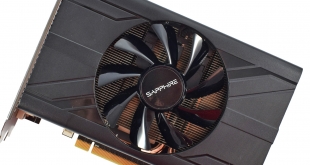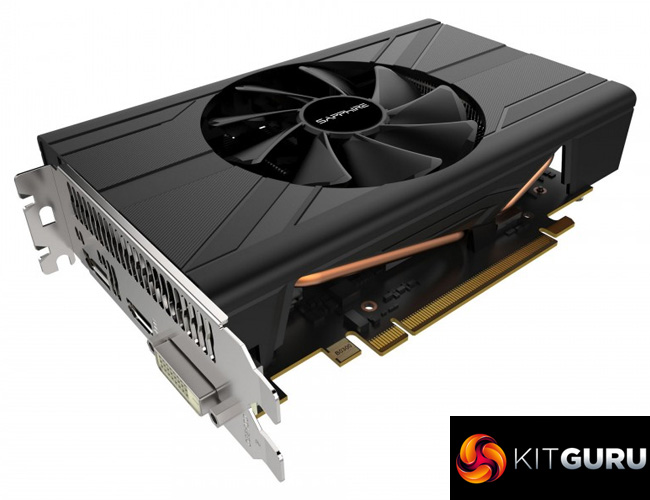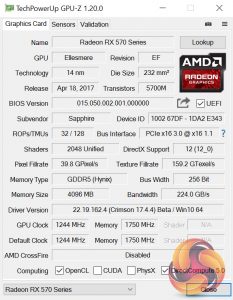
Having analysed a few of the new AMD RX 500-series cards since launch, today our attention turns back to the RX 570. This particular card is Sapphire's RX 570 Pulse ITX model, and it is specifically aimed at those looking to build a SFF or ITX system – this is made clear by the card's small size and single-fan cooling solution. Is it an effective option for those with very strict space constraints?
We know by now that the RX 570 GPU is best for 1080p gaming, so the focus of this review today is whether or not the Sapphire RX 570 Pulse ITX is an effective implementation of the Polaris architecture. Given it is aimed at the SFF and Mini-ITX markets, its thermal and power consumption levels are of particular importance.
| GPU | AMD RX 480 | AMD RX 580 | AMD RX 470 | AMD RX 570 | AMD R9 390 |
Nvidia GTX 1050 Ti | Nvidia GTX 1060 |
| Streaming Multiprocessors / Compute Units |
36 | 36 | 32 | 32 | 40 | 6 | 10 |
| GPU Cores | 2304 | 2304 | 2048 | 2048 | 2560 | 768 | 1280 |
| Texture Units | 144 | 144 | 128 | 128 | 160 | 48 | 80 |
| ROPs | 32 | 32 | 32 | 32 | 64 | 32 | 48 |
| Base Clock | 1120 MHz | 1257 MHz | 926 MHz | 1168 MHz | Up to 1000MHz | 1290 MHz | 1506 MHz |
| GPU Boost Clock | 1266 MHz | 1340 MHz | 1206 MHz | 1244 MHz | Up to 1000MHz | 1392 MHz | 1708 MHz |
| Total Video memory | 4096 or 8192 MB | 4096 or 8192 MB | 4096 or 8192 MB | 4096 MB | 8192 MB | 4096 MB | 6144 MB |
| Memory Clock (Effective) |
1750 (7000) or 2000 (8000) MHz | 2000 (8000) MHz | 1650 (6600) MHz | 1750 (7000) MHz | 1500 (6000) MHz | 1752 (7008) MHz | 2002 (8008) MHz |
| Memory Bandwidth | 224 or 256 GB/s | 256 GB/s | 211 GB/s | 224 GB/s | 384 GB/s | 112 GB/s | 192 GB/s |
| Bus Width | 256-bit | 256-bit | 256-bit | 256-bit | 512-bit | 128-bit | 192-bit |
| Manufacturing Process | 14nm | 14nm | 14nm | 14nm | 28nm | 16nm | 16nm |
| TDP | 150 W | 185 W | 120 W | 150 W | 275 W | 75W | 120 W |
It is definitely worth noting that the RX 570 Pulse ITX does not come with any sort of factory overclock – the card's 1244MHz boost clock is the same as AMD's reference figure. This will negatively impact performance compared to other, factory overclocked RX 570 cards such as the ASUS Strix RX 570 or Sapphire Pulse RX 570, but it will likely help keep core temperatures down.
As it is also a member of Sapphire's Pulse family, this ITX card lacks many features we would expect from a high-end card. For example, there is no backplate, RGB LEDs or dual-BIOS functionality. This is a SFF card designed simply to work in a constricted environment.
 KitGuru KitGuru.net – Tech News | Hardware News | Hardware Reviews | IOS | Mobile | Gaming | Graphics Cards
KitGuru KitGuru.net – Tech News | Hardware News | Hardware Reviews | IOS | Mobile | Gaming | Graphics Cards





What kind software that you use for gpu oc stress testing?
I have the same card and test it through unigine valley, i could pull it to 1400mhz on core and 2000mhz on memory ,
Im not noticing any artifacts, but not quite sure cause i only use 720p 24inch hdtv
wanna stress the shit out of the card and drive the temps to the max?download primecoin wallet and run claymore primecoin miner.Then u will see the real temps and how good the cooler is.
wanna stress the shit out of the card and drive the temps to the max?download primecoin wallet and run claymore primecoin miner.Then u will see the real temps and how good the cooler is.
Using software?
Give it more juice. Increase the power limit so your card won’t throttle.
Why is the RX 570 pulse mini drawing 10 more watts than a regular Rx 570 in idle? If anything it should be the other way round, with the mini using less power in idle. Is it a typing error here?
Just bought two for mining and gaming, they arrive in a couple of days, looking forward seeing what they can do